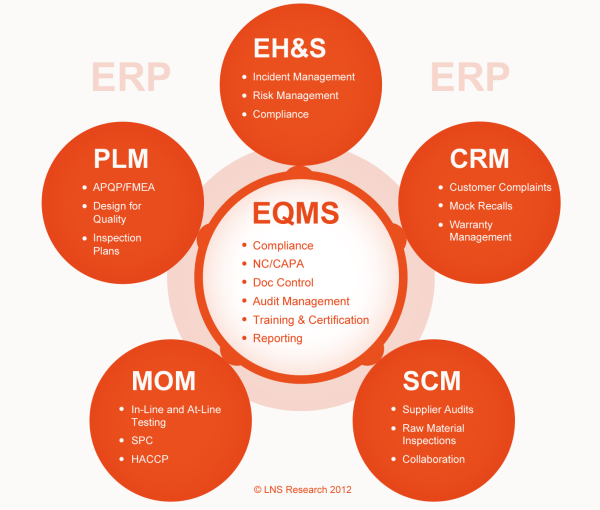Although most executives and plant managers have a different idea of what operational excellence is, everyone seems to be striving for it. Last week we broke down the LNS Research operational excellence model, stating the need for identifying strategic objectives, actionable metrics, and benchmarking opportunities. Implementing and benefitting from this model requires the right mix of people, processes, and technologies, which we believe can be greatly facilitated with a strong, integrated quality management system.
In this post, we'll examine how companies need to weigh and balance the strategy of building out functional expertise in each area of the value chain in relation to orchestrating workflows across those different silos. We will also look specifically at quality management, discussing how it should be an important factor in both IT architecture strategy and aiding the flow of information across functional silos.
Managing Quality across the Value Chain
Because quality so greatly affects profitability, brand equity, and numerous other important aspects of business performance, LNS Research places it at the center of the value chain. This is in contrast to the traditional thought of a linear value chain, where information feeds from one process or department to another, bypassing integral opportunities for collaboration and cross-functional conversations. The figure below depicts this, showing Enterprise Quality Management Software (EQMS) strategically touching CRM, SCM, EH&S, PLM, and MOM.

Manufacturing IT Architecture
Today, where intricate manufacturing and industrial processes are prevalent, most large and even small to mid-sized companies have some type of enterprise application as the backbone of operations. The level of depth in expertise and functionalities needed across specific areas of the value chain really depends on the size and nature of the company.
What we’re seeing is that some organizations are still employing homegrown solutions, while most others are leveraging and pushing the capabilities of ERP systems. However, just as manufacturing automation has evolved over time, so have IT architectural strategies. Executives and decision-makers need to embrace new capabilities and approaches to find the right architecture to suit their needs.
Choosing the Right Corporate IT Strategy
The above infographic shows the impact of quality on the value chain. You'll notice that ERP forms the IT backbone for orchestrating business processes, but EQMS plays a central role in managing quality across the value chain.
Over the past five to ten years, ERP vendors have done a good job of expanding capabilities to support multiple aspects of operations. However, just because the ERP system is generally the primary system, that doesn't mean it's the only system of importance. Even today, most ERP systems have gaps in areas that may be critical to the competitive advantage of certain companies in manufacturing, engineering, or logistics. In these cases, we are now seeing market leading companies either take a two-tiered strategy to ERP or a multiple platform approach with additional investments being made in EQMS, PLM, MOM, and SCM.
The question in establishing the right IT architecture focuses on how specific and strong do your quality functionalities need to be. Many smaller companies are finding that an industry specific ERP is the most cost-effective way to deliver the needed functionalities to operate smoothly and manage quality. Alternately, larger companies are seeing that ERPs are evolving, but may not yet have perfected capabilities in comparison to other “pure play” solutions. These companies, as mentioned above, are generally the ones pursuing a two or three-tier strategy for ERP, PLM, MOM, SCM, and EQMS. Outside of the polarity of very large and small businesses, mid-sized companies reside in a battleground for ERP and EQMS vendors.

Making the Right Choice
If you’re an end-user faced with this choice, there are a few things you can do:
- Assess your current quality capabilities and needs as well their strengths and weaknesses
- Understand that there are different approaches that can be taken
- Determine gaps in your functionalities
- Create an investment and IT architecture strategy
Additionally, don’t be afraid to utilize third party analysis, research, and expertise like that which can be found in the EQMS Best Practices Guide to get the most out of your architectural approach. Remember, just by keeping quality at the heart of each of these decisions, your company is most likely well ahead of the curve and pushing past many competitors.
